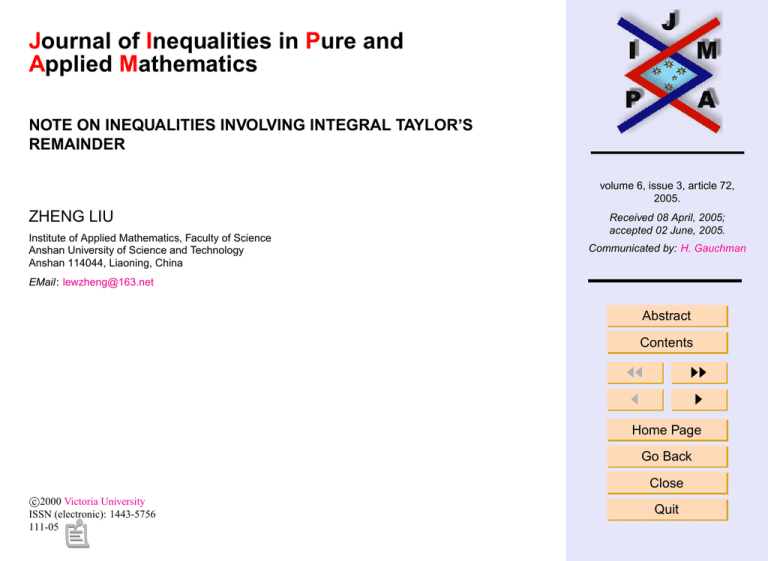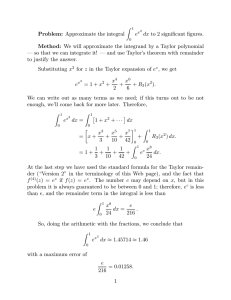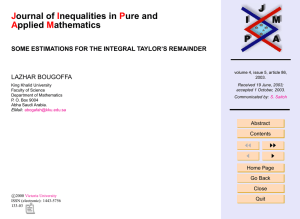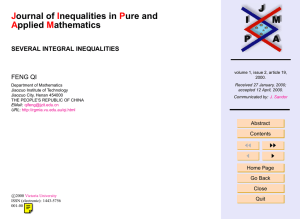J I P A
advertisement

Journal of Inequalities in Pure and Applied Mathematics NOTE ON INEQUALITIES INVOLVING INTEGRAL TAYLOR’S REMAINDER volume 6, issue 3, article 72, 2005. ZHENG LIU Institute of Applied Mathematics, Faculty of Science Anshan University of Science and Technology Anshan 114044, Liaoning, China Received 08 April, 2005; accepted 02 June, 2005. Communicated by: H. Gauchman EMail: lewzheng@163.net Abstract Contents JJ J II I Home Page Go Back Close c 2000 Victoria University ISSN (electronic): 1443-5756 111-05 Quit Abstract In this paper, some inequalities involving the integral Taylor’s remainder are obtained by using various well-known methods. 2000 Mathematics Subject Classification: 26D15. Key words: Taylor’s remainder, Leibniz formula, Variant of Grüss inequality, Taylor’s formula, Steffensen inequality. Contents Note On Inequalities Involving Integral Taylor’s Remainder Zheng Liu 1 Introduction . . . . . . . . . . . . . . . . . . . . . . . . . . . . . . . . . . . . . . . . . 3 2 Results Obtained via the Leibniz Formula . . . . . . . . . . . . . . . . 5 3 Results Obtained by a Variant of the Grüss Inequality . . . . . . 8 4 Results Obtained via the Steffensen Inequality . . . . . . . . . . . . 10 References Title Page Contents JJ J II I Go Back Close Quit Page 2 of 14 J. Ineq. Pure and Appl. Math. 6(3) Art. 72, 2005 http://jipam.vu.edu.au 1. Introduction In [4] – [5], H. Gauchman has derived some new types of inequalities involving Taylor’s remainder. In [1], L. Bougoffa continued to create several integral inequalities involving Taylor’s remainder. The purpose of this paper is to give some supplements and improvements for the results obtained in [1] – [3]. In [1], two notations Rn,f (c, x) and rn,f (a, b) have been adopted to denote the nth Taylor’s remainder of function f with center c and the integral Taylor’s remainder respectively, i.e., Rn,f (c, x) = f (x) − n X f (n) (c) k=0 n! (x − c)k , Note On Inequalities Involving Integral Taylor’s Remainder Zheng Liu Title Page Contents and Z rn,f (a, b) = a b (b − x)n (n+1) f (x)dx. n! However, it is evident that Z b (b − x)n (n+1) Rn,f (a, b) = f (x) dx = rn,f (a, b), n! a JJ J II I Go Back Close Quit Page 3 of 14 and n Z (−1) Rn,f (b, a) = a b (x − a)n (n+1) f (x) dx = (−1)n rn,f (b, a). n! J. Ineq. Pure and Appl. Math. 6(3) Art. 72, 2005 http://jipam.vu.edu.au So, we would like only to keep the notation Rn,f (·, ·) in what follows. We start by changing the order of integration to give a simple different proof of Lemma 1.1 and Lemma 1.2 in [5] and [1]. i.e., Z b Z b Z x (x − t)n (n+1) Rn,f (a, x) dx = (t)dt dx f n! a a a Z b Z b (x − t)n (n+1) = f (t)dx dt n! a t Z b (b − t)n+1 (n+1) f (t)dt. = (n + 1)! a Note On Inequalities Involving Integral Taylor’s Remainder Zheng Liu and n+1 Z (−1) a b Z b Z b (t − x)n (n+1) Rn,f (b, x)dx = f (t)dt dx n! a x Z b Z t (t − x)n (n+1) = f (t)dx dt n! a a Z b (t − a)n+1 (n+1) = f (t)dt. (n + 1)! a Title Page Contents JJ J II I Go Back Close Quit Page 4 of 14 J. Ineq. Pure and Appl. Math. 6(3) Art. 72, 2005 http://jipam.vu.edu.au 2. Results Obtained via the Leibniz Formula We prove the following theorem by using the Leibniz formula. Theorem 2.1. Let f be a function defined on [a, b]. Assume that f ∈ C n+1 ([a, b]). Then p p−1 X X (n−k) (b − a)n−k k k k f , (2.1) Cp−1 (a) (−1) Cp Rn−k,f (a, b) ≤ (n − k)! k=0 k=0 (2.2) p p−1 X X (n−k) (b − a)n−k n−k+1 k k f Cp Rn−k,f (b, a) ≤ Cp−1 (b) , (−1) (n − k)! k=0 (2.3) Note On Inequalities Involving Integral Taylor’s Remainder Zheng Liu k=0 p Z b X k k (−1) C R (a, x)dx n−k,f p a Title Page Contents k=0 ≤ p−1 X (n−k) (b − a)n−k+1 k f , Cp−1 (a) (n − k + 1)! k=0 JJ J II I Go Back (2.4) p Z b X Rn−k,f (b, x)dx (−1)n−k+1 Cpk a Close k=0 p−1 ≤ where Cpk = p! . (p−k)!k! Quit n−k+1 (n−k) (b − a) k f Cp−1 (b) , (n − k + 1)! k=0 X Page 5 of 14 J. Ineq. Pure and Appl. Math. 6(3) Art. 72, 2005 http://jipam.vu.edu.au Proof. We apply the following Leibniz formula (F G)(p) = F (p) G + Cp1 F (p−1) G(1) + · · · + Cpp−1 F (1) G(p−1) + F G(P ) , provided the functions F, G ∈ C p ([a, b]). n Let F (x) = f (n−p+1) (x), G(x) = (b−x) . Then n! p (p) X (b − x)n (b − x)n−k (n−p+1) (−1)k Cpk f (n−k+1) (x) f (x) = . n! (n − k)! k=0 Integrating both sides of the preceding equation with respect to x from a to b gives us #x=b " n (p−1) (b − x) f (n−p+1) (x) n! x=a Z b p X (b − x)n−k k k = (−1) Cp f (n−k+1) (x) dx. (n − k)! a k=0 The integral on the right is Rn−k,f (a, x), and to evaluate the term on the left hand side, we must again apply the Leibniz formula, obtaining X Zheng Liu Title Page Contents JJ J II I Go Back p p−1 − Note On Inequalities Involving Integral Taylor’s Remainder k (−1)k Cp−1 f (n−k) (a) k=0 (b − a)n−k X = (−1)k Cpk Rn−k,f (a, b). (n − k)! k=0 Consequently, p p−1 X X (n−k) (b − a)n−k k k k , Cp−1 f (a) (−1) Cp Rn−k,f (a, b) ≤ (n − k)! k=0 k=0 Close Quit Page 6 of 14 J. Ineq. Pure and Appl. Math. 6(3) Art. 72, 2005 http://jipam.vu.edu.au which proves (2.1). For the proof of (2.2), we take F (x) = f (n−p+1) (x), G(x) = (x − a)n . n! For the proof of (2.3), we take F (x) = f (n−p+1) (x), G(x) = (b − x)n+1 . (n + 1)! Note On Inequalities Involving Integral Taylor’s Remainder For the proof of (2.4), we take F (x) = f (n−p+1) (x), Zheng Liu G(x) = (x − a)n+1 . (n + 1)! Title Page Contents Remark 1. It should be noticed that (2.3) and (2.4) have been mentioned and proved in [1] with some misprints in the conclusion. JJ J II I Go Back Close Quit Page 7 of 14 J. Ineq. Pure and Appl. Math. 6(3) Art. 72, 2005 http://jipam.vu.edu.au 3. Results Obtained by a Variant of the Grüss Inequality The following is a variant of the Grüss inequality which has been proved almost at the same time by X.L. Cheng and J. Sun in [3] as well as M. Matić in [6] respectively. Let h, g : [a, b] → R be two integrable functions such that γ ≤ g(x) ≤ Γ for some constants γ, Γ for all x ∈ [a, b]. Then (3.1) Z b Z b Z b 1 h(x) dx g(x)dx h(x)g(x) dx − b − a a a a Z b Z b 1 1 h(x) − dx (Γ − γ). h(y)dy ≤ 2 b−a a a Theorem 3.1. Let f (x) be a function defined on [a, b] such that f ∈ C n+1 ([a, b]) and m ≤ f (n+1) (x) ≤ M for each x ∈ [a, b], where m and M are constants. Then f (n) (b) − f (n) (a) n(b − a)n+1 (M − m) n √ (b − a) ≤ , (3.2) Rn,f (a, b) − (n + 1)! (n + 1)!(n + 1) n n + 1 Note On Inequalities Involving Integral Taylor’s Remainder Zheng Liu Title Page Contents JJ J II I Go Back Close (3.3) (n) (n) (−1)n+1 Rn,f (b, a) − f (b) − f (a) (b − a)n (n + 1)! ≤ n(b − a)n+1 (M − m) √ , (n + 1)!(n + 1) n n + 1 Quit Page 8 of 14 J. Ineq. Pure and Appl. Math. 6(3) Art. 72, 2005 http://jipam.vu.edu.au (3.4) Z b f (n) (b) − f (n) (a) n+1 Rn,f (a, x) dx − (b − a) (n + 2)! a ≤ (n + 1)(b − a)n+2 (M − m) √ (n + 2)!(n + 2) n+1 n + 2 and (3.5) Z b (n) (n) f (b) − f (a) n+1 (−1)n+1 R (b, x) dx − (b − a) n,f (n + 2)! a n+2 ≤ (n + 1)(b − a) (M − m) √ . (n + 2)!(n + 2) n+1 n + 2 Note On Inequalities Involving Integral Taylor’s Remainder Zheng Liu n Proof. To prove (3.2), setting g(x) = f (n+1) (x) and h(x) = (b−x) in (3.1), we n! obtain (n) (n) Rn,f (a, b) − f (b) − f (a) (b − a)n (n + 1)! Z b (b − x)n (b − a)n M −m dx ≤ − n! 2 (n + 1)! a n(b − a)n+1 (M − m) √ = . (n + 1)!(n + 1) n n + 1 The proofs of (3.3), (3.4) and (3.5) are similar and so are omitted. Remark 2. It should be noticed that Theorem 3.1 improves Theorem 3.1 in [1] and Theorem 2.1 in [5]. Title Page Contents JJ J II I Go Back Close Quit Page 9 of 14 J. Ineq. Pure and Appl. Math. 6(3) Art. 72, 2005 http://jipam.vu.edu.au 4. Results Obtained via the Steffensen Inequality In [2] we can find a general version of the well-known Steffensen inequality as follows: Let h : [a, b] → R be a nonincreasing mapping on [a, b] and g : [a, b] → R be an integrable mapping on [a, b] with φ ≤ g(x) ≤ Φ, for all x ∈ [a, b], then Z (4.1) φ b−λ Z b h(x)dx ≤ h(x)dx + Φ a b Z b−λ Note On Inequalities Involving Integral Taylor’s Remainder h(x)g(x)dx a Z ≤Φ a+λ Z h(x)dx + φ a Zheng Liu b h(x)dx, a+λ Title Page where Z (4.2) λ= b G(x) dx, a g(x) − φ G(x) = , Φ−φ Contents Φ 6= φ. Theorem 4.1. Let f : [a, b] → R be a mapping such that f (x) ∈ C n+1 ([a, b]) and m ≤ f (n+1) (x) ≤ M for each x ∈ [a, b], where m and M are constants. Then (4.3) m(b − a)n+1 + (M − m)λn+1 (n + 1)! ≤ Rn,f (a, b) M (b − a)n+1 − (M − m)(b − a − λ)n+1 ≤ , (n + 1)! JJ J II I Go Back Close Quit Page 10 of 14 J. Ineq. Pure and Appl. Math. 6(3) Art. 72, 2005 http://jipam.vu.edu.au (4.4) (4.5) m(b − a)n+1 + (M − m)λn+1 (n + 1)! ≤ (−1)n+1 Rn,f (b, a) M (b − a)n+1 − (M − m)(b − a − λ)n+1 ≤ , (n + 1)! m(b − a)n+2 + (M − m)λn+2 (n + 2)! Z b ≤ Rn,f (a, x)dx Note On Inequalities Involving Integral Taylor’s Remainder Zheng Liu a ≤ M (b − a)n+2 − (M − m)(b − a − λ)n+2 , (n + 2)! Contents and (4.6) JJ J m(b − a)n+2 + (M − m)λn+2 (n + 2)! Z b n+1 ≤ (−1) Rn,f (b, x)dx a n+2 ≤ where λ = Title Page M (b − a) f (b)−f (a)−m(b−a) . M −m II I Go Back Close n+2 − (M − m)(b − a − λ) (n + 2)! , Quit Page 11 of 14 J. Ineq. Pure and Appl. Math. 6(3) Art. 72, 2005 http://jipam.vu.edu.au n Proof. Observe that (b−x) is a decreasing function of x on [a, b], then by (4.1) n! and (4.2) we have Z b−λ Z b (b − x)n (b − x)n m dx + M dx n! n! a b−λ Z b (b − x)n (n+1) ≤ f (x)dx n! a Z a+λ Z b (b − x)n (b − x)n ≤M dx + m dx n! n! a a+λ Note On Inequalities Involving Integral Taylor’s Remainder with Zheng Liu Z λ= a b f (n+1) (x) − m f (n) (b) − f (n) (a) − m(b − a) dx = , M −m M −m and (4.3) follows. n Since (x−a) is a increasing function of x on [a, b], then n! Z a+λ Z b (x − a)n (x − a)n M dx + m dx n! n! a a+λ Z b (x − a)n (n+1) ≤ f (x)dx n! a Z b−λ Z b (x − a)n (x − a)n ≤m dx + M dx, n! n! a b−λ and (4.4) follows. The proofs of (4.5) and (4.6) are similar and so are omitted. Title Page Contents JJ J II I Go Back Close Quit Page 12 of 14 J. Ineq. Pure and Appl. Math. 6(3) Art. 72, 2005 http://jipam.vu.edu.au Remark 3. It should be mentioned that (4.5) and (4.6) have also been proved in [4] Note On Inequalities Involving Integral Taylor’s Remainder Zheng Liu Title Page Contents JJ J II I Go Back Close Quit Page 13 of 14 J. Ineq. Pure and Appl. Math. 6(3) Art. 72, 2005 http://jipam.vu.edu.au References [1] L. BOUGOFFA, Some estimations for the integral Taylor’s remainder, J. Inequal. Pure and Appl. Math., 4(5) (2003), Art. 86. [ONLINE: http: //jipam.vu.edu.au/article.php?sid=327]. [2] P. CERONE, Generalised trapezoidal rules with error involving bounds of the nth derivative, Math. Ineq. and Applic., 5(3) (2002), 451–462. [3] X.L.CHENG AND J. SUN, A note on the perturbed trapezoid inequality, J. Inequal. Pure and Appl. Math., 3(2) (2002), Art. 29. [ONLINE: http: //jipam.vu.edu.au/article.php?sid=181]. [4] H. GAUCHMAN, Some integral inequalities involving Taylor’s remainder. I, J. Inequal. Pure and Appl. Math., 3(2) (2002), Art. 26. [ONLINE: http: //jipam.vu.edu.au/article.php?sid=178]. [5] H. GAUCHMAN, Some integral inequalities involving Taylor’s remainder. II, J. Inequal. Pure and Appl. Math., 4(1) (2003), Art. 1. [ONLINE: http: //jipam.vu.edu.au/article.php?sid=237]. [6] M. MATIĆ, Improvement of some estimations related to the remainder in generalized Taylor’s formula, Math. Ineq. and Applic., 5(4) (2002), 617– 648. Note On Inequalities Involving Integral Taylor’s Remainder Zheng Liu Title Page Contents JJ J II I Go Back Close Quit Page 14 of 14 J. Ineq. Pure and Appl. Math. 6(3) Art. 72, 2005 http://jipam.vu.edu.au




